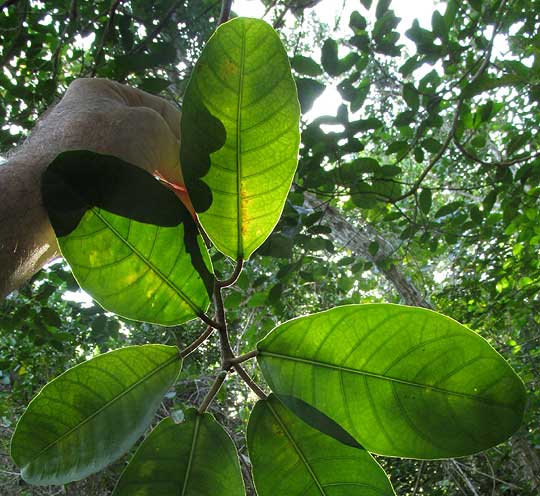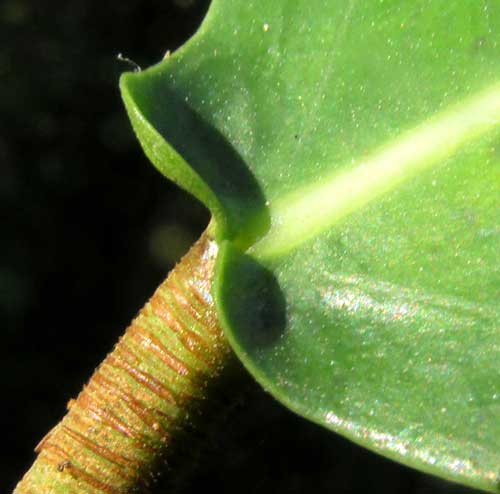Excerpts from Jim Conrad's
Naturalist Newsletter
from the January 4, 2015 Newsletter issued from Río Lagartos, on the Yucatan Peninsula's northern coast (~N21.60°, ~W88.16°), Yucatán state, MÉXICO
WILD FIG
Deep inside a mangrove swamp between Río Lagartos and Las Coloradas there's a picturesque little pond issuing freshwater, and accessible by a trail. It's so isolated that uncommonly seen plants and animals turn up there. During my last visit I heard Spider Monkeys which I've not encountered elsewhere in these parts. Locally the pond is known as Petén Tucha.
Beside Petén Tucha there's a wild fig tree I've not encountered elsewhere, either. It doesn't seem to be a "strangler fig" with multiple trunks fusing as time goes by. Its form is that of a regular tree with a single trunk and no buttresses, which big fig trees often have. Its leaves are especially large for an American fig species, as you can see below:

Normally in plant identification you need flowers and/or fruits to be sure of what you have, but among the figs, genus Ficus, often you can go a long way just using vegetative characters. For example, in the above picture important field marks to note other than the leaves' large size is the number of veins along each side of the midrib, and the fact that the bottom-most pair form sharper angles with the midrib than other veins. Also, the leaf tips are blunt, not sharp. Other important features are shown below:

The green, upright, conical item is a typical terminal bud. Notice the "stipular ring" encircling the stem where the top of the leaf's petiole attaches to the stem; that helps us identify this as a member of the Fig Family. More diagnostic for this particular species is that the leaf petioles are round in cross section, not flattened on top or channeled, and -- definitive for this species -- the petioles are invested with loose, flaky scales. An even more spectacular feature, which leaves me scratching my head, is shown below:
 .
.
This leaf base not only is slightly lobed on both sides of the midrib, but also the lobes curl upward forming cuplike depressions. I've never seen anything like this among the figs, and the species this appears to be is not described as having anything like this. On Internet images of leaves of the species sometimes larger leaves do display modest ears and slight thickening of the lobes, hinting at something going on, but these turned-up lobes just aren't supposed to be there and I don't know what to do about them.
Still, especially because of the flaky scales on the petioles and the limited number of fig species known to occur in the Yucatan, this fig keys out to FICUS MAXIMA. Apparently there's no English name for it but sometimes in the Yucatan it's called Higo Grande, which simply means "Big Fig." Our tree stood only about 25 feet high (8m) but I read that in areas with more rainfall they can reach 100 ft (30m). The species is distributed from Southern Mexico to the Amazon basin, plus the Caribbean. Throughout its extensive area of distribution it occupies a variety of moist habitats, but is never very common.
I read that the fruits and leaves of Higo Grande are eaten by a variety of birds and mammals. Like all figs, it displays an obligate mutualism with fig wasps; Ficus maxima is pollinated only by the fig wasp Tetrapus americanus, and T. americanus only reproduces in Ficus maxima flowers.
Injured fig leaves exude milky latex often used in folk medicine, but the uses vary from culture to culture across the species' large distribution area. The Lacandón of Chiapas, southern Mexico, have been documented chewing and moistening Ficus maxima leaves for application to snakebites. In the Yucatan I read that somehow the tree has been used for asthma.